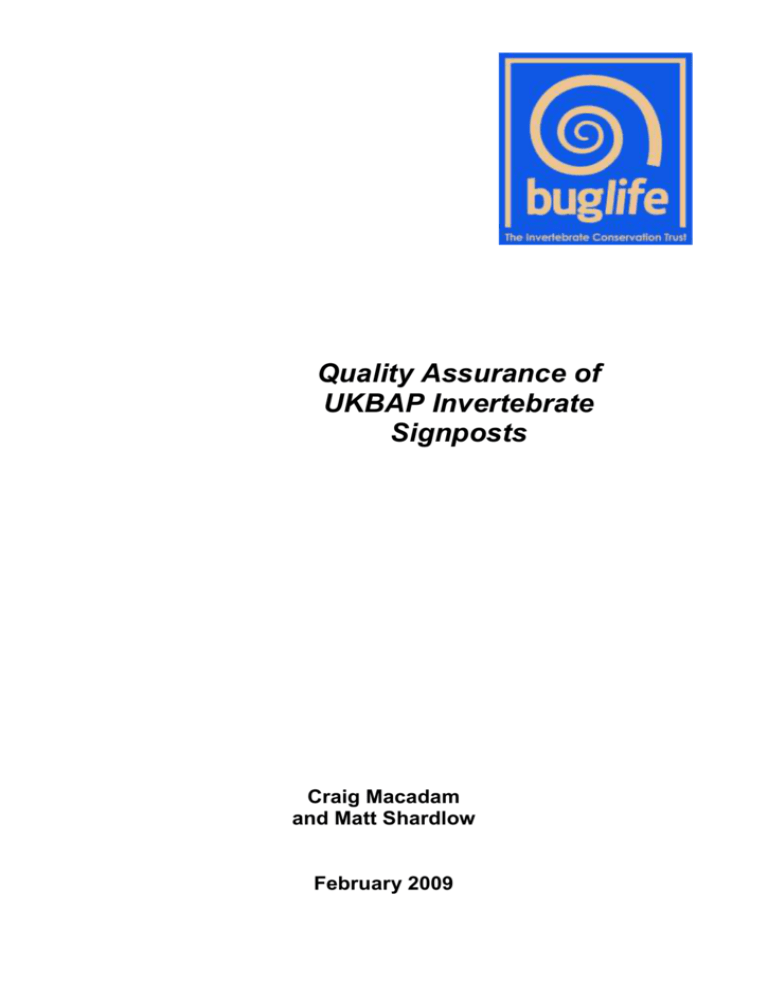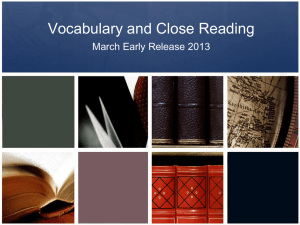Quality Assurance of UKBAP Invertebrate Signposts
advertisement

Quality Assurance of UKBAP Invertebrate Signposts Craig Macadam and Matt Shardlow February 2009 Quality Assurance of UKBAP Invertebrate Signposts Craig Macadam and Matt Shardlow, February 2009 Executive Summary The ‘Categorisation (signposting) of the priority action for the UK BAP priority species’ was published on the UKBAP website in May 2008. The signposts had been generated by taxonomic working groups. Each working group followed its own process for defining the signposts and the level of effort put into the development of the signposts varied according to the resources available to each working group. During initial stages the concept was that there could be only three signposts for each species and that the purpose of the signposts would be to indicate the category of action required. As the list review process continued there was a shift in the concept and the signposts were remoulded as the new actions that would be needed to ensure the delivery of the conservation of each species. Eventually the restriction to three signposts was replaced with a restriction to six signposts. Again each taxonomic working group was only able to react to the changing concept of signposts in proportion to the resources available to do so. In December 2007 the Joint Nature Conservation Committee (JNCC) consulted with species experts on the actions required for UKBAP priority species. For terrestrial and freshwater invertebrates experts were asked to check and redefine the signposts that had been identified incidentally during previous stages of the list review process. Species experts, many of whom are volunteers, were given two months to complete this task and as a result little, if any, consultation was possible amongst experts. Concerns have been raised about the quality and comprehensiveness of the resulting signposts/actions identified for UKBAP priority invertebrate species. The fear is that if BAP conservation action is founded on flawed invertebrate signposts then the resulting action will not be cost effective or indeed successful in Halting the Loss of Biodiversity. The aim of this Quality Assurance of the list of invertebrate signposts is to establish the extent of the discrepancy between the signposts and the actual actions required to deliver conservation of the BAP listed species. The general quality standard of the invertebrate signposts/actions is low. Most of the signposts/actions lack detail and many represent a statement of current knowledge only. Examples of the inadequacies of the signpost/actions include:- Over 50% of the research signposts/actions do not detail the research that is required. Almost 50% the priority habitat actions do not contain any detail of the action required. Prescriptive habitat actions are particularly poor, 74% providing no prescriptive element at all. A small minority of species have been done well and have sound actions, but it is impossible for the non-specialist to determine which signpost sets are sound and which are underdeveloped. The conclusion is that as they stand the signposts for terrestrial and freshwater invertebrates are not an adequate basis for devising country or local delivery actions. Reasons why the invertebrate signposts are inadequate are discussed. The following recommendations are made:1) Country and local biodiversity groups and actors should be aware of the shortcomings in the terrestrial and freshwater invertebrate signposts/actions and urged to use them with caution. 2) Delivery plans should be developed in partnership with species specialists to set targets and then determine the actual actions required to meet those targets. To make effective use of very limited number of (rather process disenchanted) experts this should be done on a UK basis in the first place and then broken down by country and local area for deliver. These delivery plans should not be limited to a maximum number of actions. They should document the steps required to ensure species recovery. 3) The delivery plans should be made widely available so that BAP groups at all levels have a sound basis for developing biodiversity delivery actions. Note - These findings relate only to the terrestrial and freshwater invertebrate signposts, taxonomic groups that had more resources available to undertake this process have much more carefully formulated signposts. Introduction The review of the lists of BAP Priority species was undertaken between 2005 and 2008. Coordination of the gathering and assessment of the data required to asses the species against the criteria for listing was undertaken by a series of taxonomic working Group. For the terrestrial and freshwater invertebrates this was undertaken by the Invertebrate BAP Working Group chaired by Butterfly Conservation and the JNCC. During the process of assessing the species submissions it was decided that to enable the planning of the delivery of conservation action it would be expedient to identify the delivery categories of into which actions would fall. Each species would be signposted to a delivery category. It was soon clear that each species needed a suite of actions and that these could not be allocated to just one category. The responsibility for defining the signposts was given to the taxonomic working groups. Each working group followed its own process for defining the signposts and the level of effort put into the development of the signposts varied according to the resources available to each working group. During initial stages the concept was that there could only be three signposts for each species and that the purpose of the signposts would be to indicated the category of action required. As the list review process continued there was a shift in the concept and the signposts were remoulded as the new actions that would be needed to ensure the delivery of the conservation of each species. Eventually the restriction to three signposts was replaced with a restriction to six signposts. Again each taxonomic working group was only able to react to the changing concept of signposts in proportion to the resources available to do so. In December 2007 the Joint Nature Conservation Committee (JNCC) consulted with species experts on the actions required for UKBAP priority species. Experts on terrestrial and freshwater invertebrates were asked to: Check that the actions that were assigned to the species earlier in 2007 are appropriate Identify to which countries each action applies Check the country distribution of the species Determine success criteria (or at least milestones towards these success criteria) Species experts, many of whom are volunteers, were given two months to complete this task. Unfortunately this coincided with the festive break, meaning that the at best 6 weeks were available. As a result little, if any, consultation was possible amongst experts. The resulting signposts were produced as ‘Categorisation (signposting) of the priority action for the UK BAP priority species’ on the UKBAP website in May 2008. Concerns have been raised about the quality and comprehensiveness of the signposts/actions identified for UKBAP priority invertebrate species as a result of this process. 64% of all species are invertebrates and all the fastest declining taxonomic groups of British organisms are invertebrates. Therefore fear is that if BAP conservation action is founded on flawed invertebrate signposts then the resulting action will not be cost effective or indeed successful in Halting the Loss of Biodiversity. The aim of this Quality Assurance of the list of invertebrate signposts is to establish the extent of the discrepancy between the signposts and the actual actions required to deliver conservation of the BAP listed species. The Quality Assurance details some of the problems with the terrestrial and freshwater invertebrate data. The report is split into the main categories of actions:Research actions Wider landscape actions Monitoring and Surveying Prescriptive habitat actions Priority habitat actions Species-specific management action Research actions There are 319 signpost/actions actions for research. 52% (166) of these don’t give details of what research is required. There is at least one signpost/action categorised for research where it should be in another category: Ophonus melletii – “Wider countryside measures to conserve functional lowland calcareous grassland should benefit this species. O. melletii requires calcareous soils; bare ground and soil disturbance. It also needs abundant seeds provided by a diversity of flowering plants.” More worryingly, there are 34 signposts/actions that contain research actions but have been placed in a different category. Examples of Bad Research Actions Fancy-legged fly (Campsicnemus magius) – “Detailed autecology unknown”. This begs the question – what do we need to know? There are 54 moth species with the signpost – “need to gain a better understanding of autecology”. Which aspect of their autecology do we want to understand? In some cases this signpost is supplemented with a note such as “larvae proving difficult to find” or “larval requirements poorly known”. If the issue is that we need to know about the larval requirements then this should be spelt out. White-clawed crayfish (Austropotamobius pallipes) – “Establish effective control mechanisms against non native species that effect native populations”. This signpost/action is currently categorised for monitoring/survey however it is actually concerned with developing control mechanisms for non-native species. Examples of Good Research Actions Glutinous snail (Myxas glutinosa) – “Commission further autecological research which would allow more informed site management decisions. Further research is required into water quality definitions for the species, clarification of the species lifecycle and dietary requirements”. This signpost clearly defines the research that is required: water quality requirements; species lifecycle; and dietary requirements. The Borders dance-fly (Empis limata) – “Research into the autecology and life history of this species. Knowledge about the insect’s life history and requirements needs to be translated into management advice and action. On known sites swarm sites need to be identified to ensure provision of suitable swarm habitat. Swarms need to be watched to see who is leading in the display and if prey swapping happens. Identification of prey items will give indications of the hunting range of which ever sex is presenting the prey and if they are hunting over the river or fields, in shade or sun light. After mating pairs might rest on the ground - where are these sites, they might be close to oviposition sites. Does flower feeding / use occur?” This signpost is very detailed and covers life history, swarm habitat, hunting range, resting/oviposition sites and investigation other sources of food. Wider landscape actions Often the signposts don’t spell out the action that is required or species are signposted for wider landscape actions but the action is isn’t. There are three actions that are ‘unassigned’ as they do not contain any action at all. Examples of Bad Wider Landscape Actions Small brown sedge (Glossosoma intermedium) – “Pollution from sheep dip and effluent run-off presumed to have affected the three streams this species has been recorded from”. What is the action? Improve water quality in rivers? Regulate the use of sheep dip? Control diffuse pollution? Research cause of decline? Sea-wormwood leafhopper (Chlorita viridula) – “Protection of specific saltmarsh sites from development. Appears to be genuinely confined to the Thames estuary and north Kent coast. Principle threat: habitat destruction due to development in an area that is under severe development pressure. Construction and/or renovation of sea defences, or managed coastal retreat, that results in destruction of host plant”. This action clearly states that it is directed at “specific saltmarsh sites” and is therefore a site-specific management action rather than a wider landscape issue, however the principle threats listed in this signpost suggest that there may be wider landscape actions that would benefit this species. Aspen hoverfly (Hammerschmidtia ferruginea) – “Increase public awareness”. This isn’t a landscape action – it should be in species specific awareness raising. Examples of Good Wider Landscape Actions Hornet robberfly (Asilus crabroniformis) – “Link with various mechanisms for assisting farming to be wildlife-friendly - in particular grazing regimes. Policy on use of Avermectins (wormers and boticides used for treating livestock). Address habitat loss or deterioration: grassland improvement, overgrazing, absence of suitable dung, heath fires”. This signpost clearly indicates the wider actions that are required: changes to grazing regimes; restriction on the use of Avermectins; and reversing habitat loss/deterioration, however they are an amalgamation of several separate actions and at present do not detail the mechanisms required to implement the action, nor who should be responsible for implementing the action. This is a common problem across all categories with approximately 20% of actions containing more than one type of action. Thames ram’s horn snail (Gyraulus acronicus) – “Wider countryside measures to conserve densely vegetated river margins and high water quality are likely to benefit this species. The effects of boat traffic may be a primary cause for the decline of this species. The presence of moorings, locks and marinas, combined with the effects of dredging the channel, and bow waves from the continuous boat traffic have to a considerable extent, affected the habitat, such that there are now few areas with quiet, stable and well-vegetated margins. None of the tributaries of the Thames which support G. acronicus have any boat traffic”. This signpost explains (in a rather long-winded fashion) that controls on boat traffic in the Thames would benefit this species. Monitoring and Surveying The majority of Monitoring and Surveying actions are for Lepidoptera. For moths (68 species) the action is “The National Macro-moth Recording Scheme and Rothamsted Insect Survey should be supported and resourced to provide trend data for this widespread but declining species, so that success criteria and targets can be reported against”. For butterflies (17 species) there are actions with slight variations on “Encourage monitoring at key sites, co-ordinate data and produce trend for UK and national indicators”. The remaining signposts/actions in this category have the standard text supplied by JNCC: “Survey is needed to find any new sites, monitoring is needed to understand the status of the species at existing sites. These data are needed to allow reporting against success criteria”. Prescriptive habitat actions It is difficult to find an example of this signpost being applied correctly to invertebrates. Most actions in this category give little detail of the prescriptions required, instead they either make a link to a priority habitat (they therefore should be priority habitat actions) or they make a vague reference to broad habitat management requirements. Examples of Bad Prescriptive Habitat Actions Drab looper (Minoa murinata) – “a species associated with Wood Spurge and found in open woodland situations”. What is the action? Is it to plant more Wood Spurge or open up woodlands? This is not prescriptive. Great Yellow Bumblebee (Bombus distinguendus) – “This is one of a group of seven bumblebees that require management of sward height to maintain optimum flower levels: Bombus distinguendus, Bombus humilis, Bombus muscorum, Bombus ruderarius, Bombus ruderatus, Bombus subterraneus (extinct but UK genotype survives in New Zealand), Bombus sylvarum” If this was prescriptive it would tell us what sward height this species requires and how to achieve it. At present it is difficult to see what the method or mechanism for achieving this is. Priority habitat actions Of 65 priority habitat actions, 48 of these (74%) do not contain any actions. The priority habitat actions for the spiders are actually notes that indicate which priority habitat the species should be linked to. Examples of Bad Priority Habitat Actions Elegant blunt-brow spider (Silometopus incurvatus) – “This species could be part of an integrated sand dune HAP”. Wormwood moonshiner (Amara fusca) – “Link to host plant BAP: Artemisa campestris”; Heath short-spur (Anisodactylus nemorivagus) – “Ensure this species is catered for by the Lowland Heathland HAP”. None of these actions are actions. Examples of Good Priority Habitat Actions Streaked bombardier beetle (Brachinus sclopeta) – “Secure sufficient habitat for the species long term survival in the London and Thames Gateway area”; Southern damselfly (Coenagrion mercuriale) – “Expand the UK range by restoring habitat in additional 36 one-km squares in England and Wales to achieve larger and better linked population clusters by 2015”. Species-specific management action As with Priority habitat actions there has been some confusion over what an action is and what ‘mapping’ is. There are a number of species with actions such as – “This species could be part of an integrated Blanket Bog HAP”. Clearly these are mappings not actions. Examples of Good Priority Habitat Actions Purbeck mason wasp (Pseudepipona herrichii) – “Appropriate management is required to provide strong growth of young heather shoots which support larvae of the moth Acleris hyemana, the prey of the wasp. Areas of open bare ground with access to wet clay must also be provided for nesting” Mottled bee-fly (Thyridanthrax fenestratus) – “On known sites for this species: curtailment of all heathland path and track hard surfacing schemes and creation of at least three completely horse-free sandy paths or tracks on each lowland heathland site and creation of additional tracks or bare areas on slopes, where erosion will occur on some heathland sites, e.g. Lavington Common, West Sussex, which does not have sufficient bare ground in the form of tracks or other areas”. Conclusions While there are exceptions the general quality standard of the terrestrial and freshwater invertebrate signposts/actions is low. Most of the signposts/actions lack detail and many represent a statement of current knowledge only. Over half of the research signposts/actions do not detail the research that is required. Almost half the priority habitat actions do not contain any detail of the action required. Prescriptive habitat actions are particularly poor, 74% providing no prescriptive element at all. Many signposts/actions contain multiple actions, in some cases covering more than one category. A number of signposts/actions have been placed in the wrong category. The conclusion is that as they stand the signposts for terrestrial and freshwater invertebrates are not an adequate basis for devising country or local delivery actions. They may be of interest as indicative actions and of course a small minority of the species have been done well and have sound actions, but it is impossible for the non-specialist to determine which signpost sets are sound and which are underdeveloped. There are a number of reasons why the invertebrate signposts are inadequate:1) 2) 3) 4) Insufficient resources – there was not enough time or capital to ensure that all the species listed were properly considered by experts. Confusion about definitions – many contributors did not understand the term signpost having been familiar with the term action. Lack of an end point – the process attempted to define what actions were required before determining what the target for the species was. This created a lack of consistency in the ambition or specificy of the signposts. There was no quality assurance by experts of the allocation of the signposts to categories. Recommendations 1) Country and local biodiversity groups and actors should be aware of the shortcomings in the terrestrial and freshwater invertebrate signposts/actions and urged to use them with caution. 2) Delivery plans should be developed in partnership with species specialists to set targets and then determine the actual actions required to meet those targets. To make effective use of very limited number of (rather process disenchanted) experts this should be done on a UK basis in the first place and then broken down by country and local area for deliver. These delivery plans should not be limited to a maximum number of actions. They should document the steps required to ensure species recovery. 3) The delivery plans should be made widely available so that BAP groups at all levels have a sound basis for developing policy, habitat and species level delivery actions.






